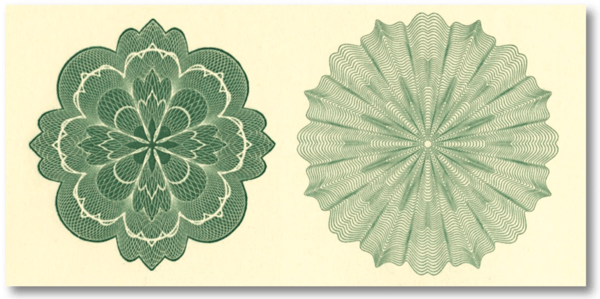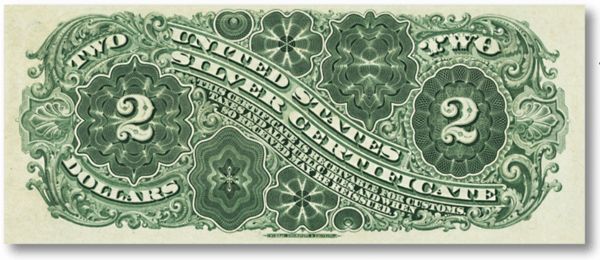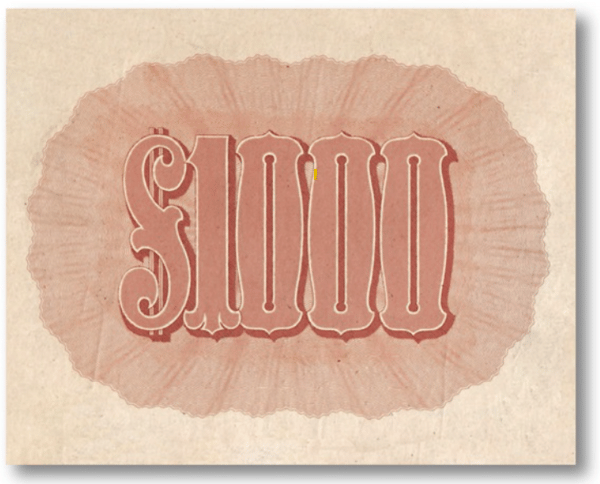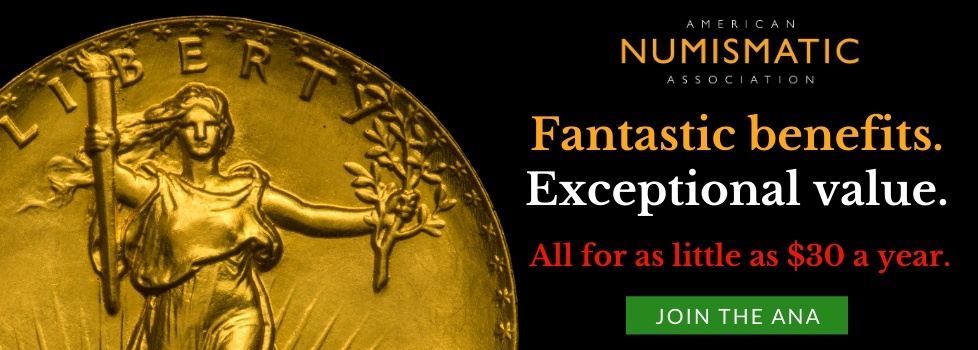Abstractions of Value
Originally published in The Numismatist, September 2014
Ornamental art engraved by geometric lathes in the 1800s is as beautiful and instantly credible today as when it was created.
When numismatic literature approaches the subject of bank-note aesthetics, it tends to give more attention to pictorial features than abstract or ornamental embellishments. This is despite the fact that some of the most instantly recognizable motifs printed on money are geometric patterns created by a machine, rather than images incised by an engraver.
▼ MECHANICAL ENGRAVINGS on financial instruments, such as bank notes and stock certificates, provided security and promoted public trust. Photo: ABNCo.
 Mechanical engraving grew out of the “reproductive engraving” industry in the late 18th century as a practical means of speeding up repetitive tasks, such as tooling intricate backgrounds and textures. However, automated and more abstract engravings were developed specifically for securing the credibility of printed money. Ornamental hybrids of human computation and mechanical execution, these abstract designs are underappreciated. Before they appeared on paper money, such complex abstractions were virtually unknown in both the fine and the decorative arts. (The closest predecessors were tracings made using relatively simple devices, such as the “geometric pen” invented by Italian mathematician Giambattista Suardi in the 18th century.)
Mechanical engraving grew out of the “reproductive engraving” industry in the late 18th century as a practical means of speeding up repetitive tasks, such as tooling intricate backgrounds and textures. However, automated and more abstract engravings were developed specifically for securing the credibility of printed money. Ornamental hybrids of human computation and mechanical execution, these abstract designs are underappreciated. Before they appeared on paper money, such complex abstractions were virtually unknown in both the fine and the decorative arts. (The closest predecessors were tracings made using relatively simple devices, such as the “geometric pen” invented by Italian mathematician Giambattista Suardi in the 18th century.)
In the 1830s, machined patterns became popularly understood as signs of authenticity, helping people recognize and trust financial instruments, such as bank notes and bonds. For this reason, their function is intrinsic to the notion of “bearer security”: they certified printed money by establishing the conventions for its appearance, and encouraged its circulation with no need for personal endorsement.
Engraved scenes and characterizations worked toward the same ends, but by slightly different means. This is reflected not only in how they looked, but also in the manner in which they communicated a sense of value. Portraits and vignettes always are anchored to geographical locations and political circumstances. They convey stories about people and events that contribute to a nation’s identity and showcase the aesthetic standards of particular cultures. For example, consider allegorical figures of Science and Commerce, as well as archetypal images of prosperity, such as factory smokestacks and pastoral fields. Such images quickly establish the notes’ 19th-century provenance. Even the portraits of stately bearded gentlemen and grizzled war generals—men who should command respect for eternity—are indicative of a stylistic currency that has depreciated over time and distance. (The depiction of George Washington as a semi-nude Greek god is a good example.)
Machined abstraction, on the other hand, expresses the workings of a technology, rather than the sentiments of the picturesque. It provides no convenient reference to personalities or events, but is accepted simply as a means of deterring counterfeiting. Perhaps this is one reason why its history and the extent of its use is less understood and researched.

▲ TWO ROSETTES created by American Bank Note Company (ABNCo) using a geometric lathe. The one at the left is composed of white lines; the other is made up of dark lines. Photo: ABNCo.
Abstractions are more difficult to analyze than pictures, and there is little consistent terminology to describe those that decorate money. In some cases, technical terms apply to the basic trajectory of the lines, such as sinusoidal (waves) and epicycloidal (loops), and identify some basic configurations. A “rosette,” for instance, describes the concentric accumulation of waves (or “petals”) in an elliptical arrangement, while “straight line ruling ” indicates the engraving is laid in rows. Unlike other types of decorative arts, however, there are no words, like “acanthus leaves,” “caryatids” or “volutes,” that connect machine-engraved patterns to any tangible object in the natural world. (The word “guilloche” of ten is used as a general description, but this is a borrowed term that properly refers to the interlacing of bands found on Greek and Roman architecture, rather than to any configuration of printed line.)
The preeminent machine for ornamental banknote engraving was the geometric lathe, a large, heavy device constructed of brass and steel that was capable of the most precise and intricate movements. The engravings’ visual appeal owes as much to their diminutive scale as it does to their complexity and variety of combinations. There was an impulse to make them too complicated for the eye to untangle, let alone the hand to imitate, and that was exactly their perceived strength. They served as an inextricable knot that tied the images on the printed paper to the embodiment of value.

▲ TAX REVENUE STAMPS, such as this one produced in 1875 for cigar boxes, often were intricate works of art. Charles Dickinson likely machined this example when he was at American Bank Note Company. Photo: ABNCo./Smithsonian Institution
Variation was an attribute particularly prized by early 19th-century English inventors who promoted their own versions of the lathe, a close mechanical cousin called the “geometric chuck.” Any attempt to compile a complete inventory of the designs from these machines—and at least one Englishman did so—would be like cataloging snowflakes. The ornaments are unique in detail, but at the same time strangely uniform in quantity. In fact, looking through specimen books at hundreds of machined rosettes is at once monotonous, enchanting and almost hypnotic.
Because of their prodigious output, there was little need to manufacture a great number of the costly geometric lathes. Each was capable of generating more than enough designs to satisfy the printing firm or bank that purchased it. The mechanisms were protected by patents and not widely publicized. Nor is much information available about the people responsible for programming the monetary designs, which is hardly surprising, given that both operators and machines were in the highly secretive environment of commercial security engraving. One can speculate that an individual attracted to this kind of work possessed an aptitude for both mathematics and invention (the person who developed the machine often was its operator), as well as patience that, at times, likely bordered on obsession. As with other areas of bank-note engraving, machine operation meant continuously focusing through an eyeglass on minute details, an effort that must have been made more difficult by the fact that the creative act was entirely self-referential: the artist was enmeshed in a network of abstract calculations and numbers.

▲ THE VICTORIAN ERA’S love of embellishment is obvious on this 1886 $1 Silver Certificate. The ornamentation on the front and back far exceeds its simple security function. Photos: Heritage Auctions
Lathe operators enjoyed nothing like the status accorded to well-respected pictorial engravers, such as James Smillie or Lorenzo Hatch. The machinists were largely anonymous; what we know of them comes from the fragments and notes they left behind, “recipes” that make sense only to those with specialized training. These reveal that creative intuition often was behind the calculations, a human sensibility that could recognize when a certain configuration was more attractive than others, and could combine intricate forms without pushing them too far toward an indigestible complexity. All this is evident from the notebooks, which contain more and less successful attempts at balance and harmony, and exhibit nuances of style.
Some of the ornaments illustrated here are from the Smithsonian Institution’s National Numismatic Collection and were compiled by a machine operator named Charles Wesley Dickinson (1865-1937). Among the artifacts are a scrapbook, a notebook, some engraved sheets and a number of newspaper clippings. Together, they give a frustratingly incomplete picture of two generations of Americans who worked in the late-19th-century business of bank-note engraving.
▼ SNIPPETS OF DICKINSON’S LATHE WORK are preserved at the Smithsonian Institution. Photo: Smithsonian Institution

Dickinson’s father, confusingly named Charles Wesley Dickinson Jr. (1823-1900), was an inventor, machinist and founding partner of the engraving firm Dickinson & Rowden in Belleville, New Jersey. The first geometric lathe he constructed was commissioned by a client who, it was later discovered, was running a counterfeiting operation. The contract was duly annulled, but Dickinson Jr. finished the machine to such an exacting standard that it was subsequently acquired by the U.S. Treasury Department and put into operation in Washington, D.C., around 1863. This made it one of the first such machines operated by a federal agency.
From marginal notes and sometimes contradictory accounts, it is possible to surmise that the younger Charles Dickinson began working for American Bank Note Company (ABNCo) when he was still a boy, and there he developed a talent for machine operation that allowed him somewhat fluid employment as an adult. In addition to heading the company his father founded, he was later associated with other engraving firms, including the Western Bank Note Company, International Bank Note Company and The Canada Bank Note Company. He also worked (possibly in an advisory capacity) for the Portuguese government. Sometime after 1908, he joined a group of ABNCo engravers, led by William Grant and Lorenzo Hatch, who established the Chinese Bureau of Engraving and Printing for the Quing government in Peking.
While a biography is approximate, the engravings themselves give a good idea of the technology just prior to the Civil War up to the early 20th century, by which time the language of monetary ornaments had evolved from the house styles of the private engraving firms to the imprimatur of the U.S. Bureau of Engraving and Printing. The Smithsonian’s collection also reveals the complexities of the design process, the commercial and monetary applications of the machine, and something of the pride and interest with which these operators approached two key aspects of their craft: programming and transferring.


▲ THE ABSTRACT DESIGN on the back of this 1886 $2 Silver Certificate has an almost psychedelic quality. Photos: Heritage Auctions
Programming the machine involved calculating the pitch and frequency of a single line, which was rotated and offset in such a way that it returned to the point of origin after completing a set number of cycles. Cogs of particular sizes and “teeth” were selected and arranged into gear trains which, if the calculations were correct, produced a harmonious and repeatable wave-form engraving. The subtleties of such arrangements were critical. Consisting of enclosing or overlapping curves, the abstract form was not unlike a polyphonic sound created by the vibrations of strings—the length between intervals had to be carefully engineered to avoid dissonance and produce more complex harmonies.
Transferring involved duplicating the engravings on multiple plates. A special press allowed an impression to be copied from hardened to softened steel plates, allowing any motif to be rendered in reverse (producing white lines against black, rather than black against white). More important, it permitted a single rosette to be subdivided and the fragments repeated, reversed and mirrored to create kaleidoscopic, extensible shapes. These ornamental units were arranged to build “textures” of printed certification that reflected the Victorian era’s love of embellishment and excess. (Today, we might almost describe them as “psychedelic.”) They adorn and enrich the reverse of the U.S. large-size Silver Certificates (particularly the 1886 and 1891 issues), where the machined ornament seems to go beyond its simple security function and evokes the opulence of precious metal, albeit on a small, paper canvas. A similar sense of almost palpable luxury was given to tax revenue stamps of the time, including those for cigars (see p. 32), which most likely were machined by the younger Charles Dickinson 10 years before he left ABNCo to join his father’s firm.
▼ THE GEOMETRIC COMPOSITION on this 1886 “Diamond Back” $20 Silver Certificate is beautifully executed. Photos: Heritage Auctions


Machined ornamentation soon became familiar to 19th-century Americans. Abstract, versatile and owing nothing to the rules of the picturesque, such adornments could be applied to a variety of other items—lottery tickets, diplomas, documents, advertising or wherever it was desirable to assure the credibility of a document or product. By the time the Bureau of Engraving and Printing assumed control of printing revenue stamps in 1878, the older engraving firms had found new clients in commercial fields.
Manufacturers of pharmaceutical concoctions often used machined guilloches on labels, taking advantage of the prestige and authority suggested by the official-looking designs. Engraving firms such as ABNCo sometimes printed such labels and borrowed liberally from their reserves of dies and plates that had been used in commercial bank-note production. Each label guaranteed the potency of the medicine and, by elevating its own genuineness, conjured in the consumer’s imagination a multitude of potentially lethal and inferior counterfeits.
The presence of machined guilloches evoked the clarity and status of engraved steel. For example, as a frame for the monogram of New Jersey’s Newark Corset Company, it demonstrated something of the social stature implicit in the very medium itself. Although there is no direct reference to paper money, something monetary is nevertheless implied in this commercial design.
American currency transitioned from 19th-century Victorian to 20th-century modernity without depreciation. Stylistic longevity is characteristic of machined ornamentation: it might be composed in ways that become unfashionable, but the patterns themselves are eternally modern.

▲ FOR A BRIEF TIME, American Bank Note Company produced playing cards with distinctive designs to discourage cardsharps from marking the decks. Photo: ABNCo/Smithsonian Institution
It’s easier to appreciate this quality of timelessness when the ornament is seen apart from other decorative or textual elements, for instance when it fills the back of a playing card. While not often used in this way, the designs (and their association with money) seem natural, given the use of cards in casino gaming. The two card designs shown here are specimens, probably made by the younger Dickinson for ABNCo during the short period the company produced playing cards. In 1914 the line was sold to the Russell Playing Card Company, which released a series featuring guilloche backs called “Aristocrats” that became popular among magicians and card dealers for their elegant design and smooth texture. Such intricate decoration was thought to discourage card-marking, but in the hands of magicians or cardsharps, it could also conceal the marks. Guilloches are perhaps no better than other types of ornamentation in this respect. In addition, costly steel engraving yields images with delicate surfaces, making it impractical for cards, so the currency-like designs were actually reproduced on the cheaper letterpress, making them less a guarantee of security than an inherited sign of luxury.
 ◄ MACHINED ENGRAVING elevated the monogram of the Newark Corset Company in New Jersey. Photo: ABNCo/Smithsonian Institution
◄ MACHINED ENGRAVING elevated the monogram of the Newark Corset Company in New Jersey. Photo: ABNCo/Smithsonian Institution
Among the minuscule remains of the Dickinson file in the Smithsonian archive is a series of giant numerals engraved against shapes composed of concentric lines. They are identified in the notebook as “bond tints,” indicating their intended use as background images on large paper bonds and share certificates, on which they often were overlaid with script . The composition is similar to security devices on early 19th-century bank notes that featured the denomination within a machined rosette (sometimes called a “counter”). The placement of the number on an engraved “tone” made any attempt at erasure or alteration conspicuous.
Dickinson’s bond tints are practical in this way, but also promotional. As they radiate from behind the solid letterforms, the concentric lines present the value of the certificate as one emphatic declaration—a graphic cliché familiar to us from commercial advertising. This promotional aspect of the design is inseparable from its aesthetic qualities and is an important reason why any monetary document circulates, whether fiat or convertible. In this sense, its role is social, rather than purely protective.

▲ BACKGROUND IMAGES known as “bond tints” often were overlaid with script.
Photo: Smithsonian Institution
Guilloche patterns originally were developed to discourage counterfeiting, but they also gave the serially numbered paper in people’s hands and wallets instant integrity. Such potential for value-adding was well understood by forgers who, during the periods of unregulated banking, boldly emblazoned their spurious notes with rosettes and borders printed from plates sold off by failed banks.
By the mid-1960s, geometric lathes were replaced by computer algorithms. The legacy of 19th-century abstract ornamental design, however, endures in new mediums and debased forms. Even today, guilloches adorn passports, diplomas and product advertisements, sometimes only as pixels on a computer screen. It remains to be seen whether bank notes themselves will retreat into this state of luminescence, but ornamental abstractions remain as useful and as instantly credible as they were when engraved in the Dickinsons’ workshop over a century ago.
Acknowledgment
The author would like to thank the Smithsonian Institution and its National Museum of American History for permitting the use of images from the National Numismatic Collection.
Sources & Additional Reading
Bazley, Thomas. Index to the Geometric Chuck. London: Waterlow and Sons, 1875.
Hessler, Gene. The Engraver’s Line: An Encyclopedia of Paper Money & Postage Stamp Art. Port Clinton, OH: BNR Press, 1993.
Meyer, Franz. A Handbook of Ornament. Originally published in German in 1888, it has been reprinted in numerous, readily available editions.
Stahl, Alan. Money on Paper. Princeton, NJ: Princeton University Library, 2010.
About the American Numismatic Association
The American Numismatic Association is a nonprofit organization dedicated to educating and encouraging people to study and collect coins and related items. The Association serves the academic community, collectors and the general public with an interest in numismatics.
The ANA helps all people discover and explore the world of money through its vast array of educational programs including its museum, library, publications, conventions and numismatic seminars.



